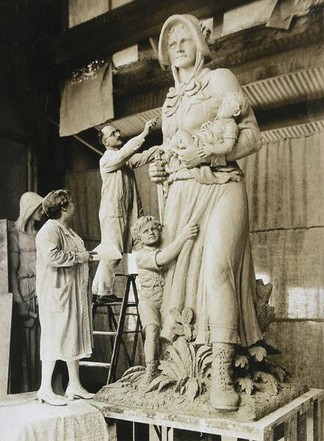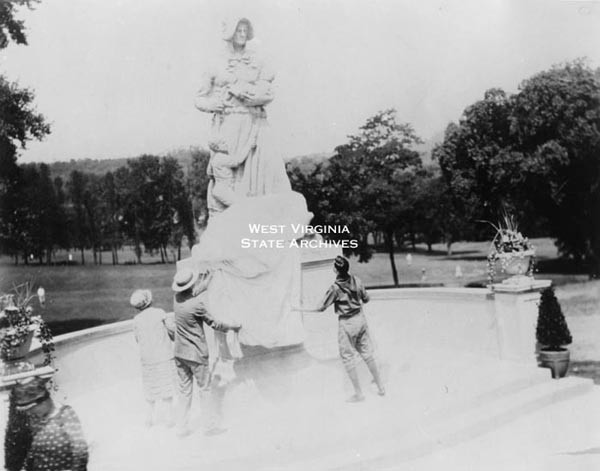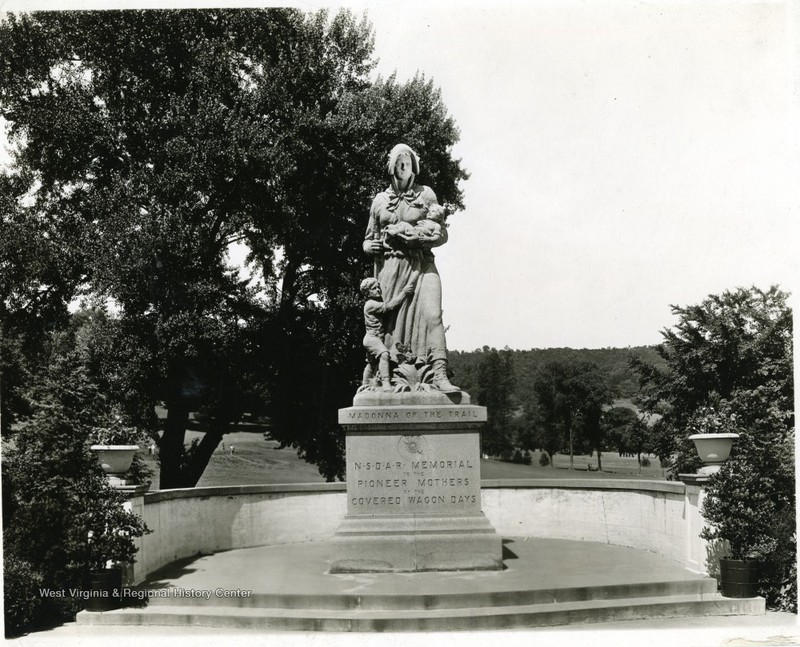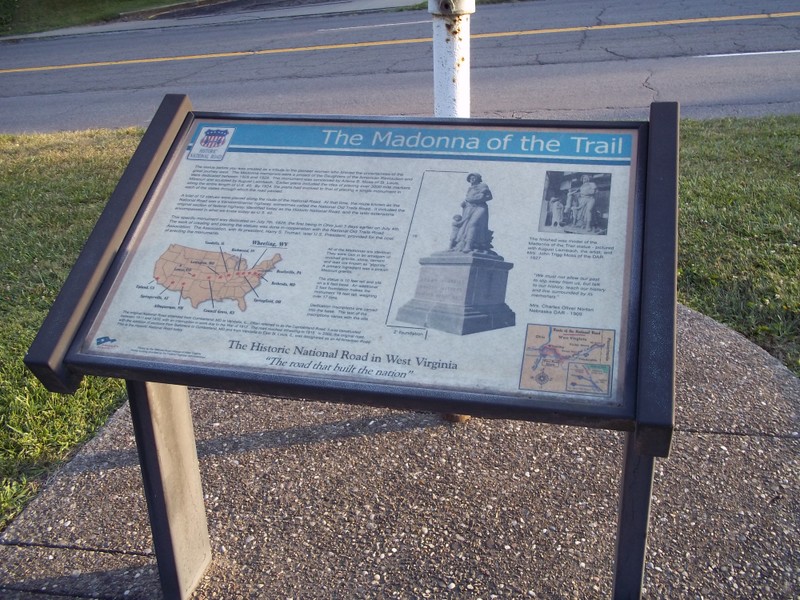Madonna of the Trail (Wheeling, WV)
Introduction
Text-to-speech Audio
Images
Madonna of the Trail.

August Leimbach sculpting the Madonna of the Trail figure.

Unveiling the Madonna statue, 1928.

Historical photo of the monument.

Informational placard at the Wheeling Madonna of the Trail Statue.

Backstory and Context
Text-to-speech Audio
With more and more Model T's rolling off the assembly line, people began to fear that society may forget about the old trails that so many people traveled. In the 1920s, a band of women petitioned their state representative, William P. Borland, to pass a bill that designated all historic trails as the National Old Trails Road. The Daughters of the American Revolution (DAR), a separate entity from the group in Missouri, wanted the current National Road that only covered the length of Cumberland, Maryland to Vandalia, Illinois to expand westward to San Francisco California. The members of the DAR set out with red, white, and blue paint with which they began to designate historical trails by painting telephone poles and fence posts. The newly established National Old Trail Road Association assisted them with this task. The bylaws of this organization stated: "the object of the Association shall be to assist the Daughters of the American Revolution in marking Old Trails and to promote the construction of an Ocean-to-Ocean Highway of modern type worthy of its memorial character." At the 1914 Annual American Road Congress, the DAR made the pioneer woman gazing over yonder to the National Road their symbol and resolved to begin the process of erecting an appropriate memorial. However, World War I (WWI) halted their progress for nine years.
After WWI ended, future president of the United States, Harry S. Truman, was actually President of the National Old Trail Road Association. Truman had an intense interest in cars and road systems; in fact, while serving in France in WWI, he was fascinated by their infrastructure for the automobile and sold memberships to Kansas City Automobile, until he was appointed a sit on the bench as a Missouri judge for Jackson County in 1926. Partnered with DAR chair Arlene Moss, Truman and Moss decided to forgo the idea of planting iron markers along the National Trail in 1924. Three years later, the DAR made a decision they would have a statue: Madonna of the Trail. Moss was inspired by a Sacajawea statue that she had seen while traveling in Portland, Oregon. Moss picked twelve spots along the National Road to plant statues over the next two years, 1928-1929. The locations of the statues are: Springfield, Ohio; Wheeling, West Virginia; Council Grove, Kansas; Lexington, Missouri; Lamar, Colorado; Albuquerque, New Mexico; Springerville, Arizona; Vandalia, Illinois; Richmond, Indiana; Washington County, Pennsylvania; Upland, California; and finally, Bethesda, Maryland.
Otto Schneck, the chairman of the Wheeling Park Commission, accepted the statue on behalf of the city, and according to the minutes from the Commission's February 10, 1928 meeting, the Commission signed a contract with the National Old Trails Association and authorized a payment of $500 for the statue. Apparently, the commission faced a dilemma in choosing the inscriptions for the base of the statue, because member George W. Lutz suggested a contest for students at Wheeling Park High School to pick two inscriptions for the base of the monument. Two winners would each be awarded $15 in gold donated by Lutz, but nothing of this came to fruition. Eventually, the inscriptions for all sides of the base were decided upon. The East Face reads: "THE NATIONAL OLD TRAILS ROAD" and the West face reads: "MADONNA OF THE TRAIL N.S.D.A.R.MEMORIAL TO THE PIONEER MOTHERS OF THE COVERED WAGON DAYS.” The North Face's inscription is: "BY THE AUTHORITY OF THE UNITED STATES GOVERNMENT AND CHIEFLY THROUGH THE STATESMANSHIP OF HENRY CLAY. THIS ROAD WAS MADE POSSIBLE IN 1806” The South Face reads: "TO THE PIONEER MOTHERS OF OUR MOUNTAIN STATE WHOSE COURAGE, OPTIMISM, LOVE AND SACRIFICE MADE POSSIBLE THE NATIONAL HIGHWAY THAT UNITED THE EAST AND WEST.” The statue was constructed from a Missouri granite, called an algonite stone that contains a mixture of granite, lead, marble, stone, and cement. The statue weighs around twelve tons.
Since the Madonna of the Trail Statue was dedicated, the DAR has ensured that a spotlight shines upon her at all times. In 2013, the statue went through a $30,000 repair and restoration with funds raised by the Wheeling Chapter of the DAR. Moss had begun to grow on the statue, there were cracks from weathering, and missing corners. Madonna of the Trail was repaired and rededicated in August 2013.
Sources
Andrew, Patrick. National Road Corridor Historic District, National Register of Historic Places. June 4th 1993. Accessed February 15th 2021. https://npgallery.nps.gov/pdfhost/docs/NRHP/Text/92000874.pdf.
Brusca, Frank X. "Madonna of the Trail Madonna of the Trail - West Virginia." US Route 40. N.p., 22 Oct. 2010. Web. 2 Aug. 2016.
Chambers Jr., S. Allen. Madonna of the Trail, SAH Archipedia. January 1st 2012. Accessed February 12th 2021. https://sah-archipedia.org/buildings/WV-01-WH70.
Dedication of the Madonna of the Trail Monument, 1928, Ohio County Public Library. Accessed February 12th 2021. https://www.ohiocountylibrary.org/research/wheeling-history/5600.
e-WV: The West Virginia Encyclopedia "Madonna of the Trail." e-WV: The West Virginia Encyclopedia. 24 June 2013. Web. 02 August 2016.
"Historians Celebrate Madonna's Facelift." The Intelligencer: Wheeling News Register 21 July 2013. Web. 2 Aug. 2016.
July 7, 1928: Madonna of the Trail Dedicated, WV Public Broadcasting. July 7th 2020. Accessed February 12th 2021. https://www.wvpublic.org/radio/2020-07-07/july-7-1928-madonna-of-the-trail-dedicated.
Madonna of the Trail Monument in Wheeling, Ohio County Public Library. Accessed February 12th 2021. https://www.ohiocountylibrary.org/wheeling-history/3834.
Madonna of the Trail Statue, Daughters of the American Revolution. Accessed February 12th 2021. https://www.dar.org/national-society/historic-sites-and-properties/madonna-trail-statue-7.
"Madonna of the Trail: The Autograph of a Nation Written Across a Continent." Indiana Daughters of the American Revoltion. Ed. Danielle Kloznick. Indiana Daughters of the American Revolution, n.d. Web. 2 Aug. 2016.
Thomson, Cindy. "Madonna of the Western Trails Historic trails saved by a future president and the Daughters of the American Revolution." Truewest: History of the American Frontier. Truewest Magazine, 1 Mar. 2007. Web. 2 Aug. 2016.
1928. West Virginia Archives & History. Accessed February 12, 2021. http://www.wvculture.org/history/thisdayinwvhistory/0707.html.
West Virginia & Regional History Center. Accessed February 12, 2021. https://wvhistoryonview.org/catalog/031114.
